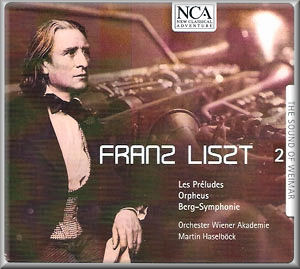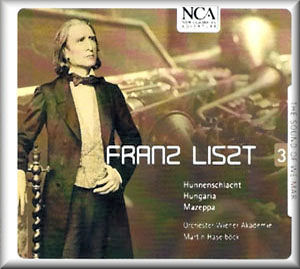 |
 |
|


alternatively
CD: MDT
AmazonUK
AmazonUS
Sound
Samples & Downloads
|
Franz LISZT (1811-1886)
The Sound of Weimar
The Authentic Sound of Liszt’s Orchestral Works
Volume 2
Les Préludes, Symphonic Poem No.3, S97 (1854, pub.1856)
[15:35]
Orpheus, Symphonic Poem No.4, S98 (1853/4) [10:27]
Ce qu’on entend sur la Montagne (Berg Symphonie),
Symphonic Poem No.1, S95 (1850, 1856) [30:12]
 Orchester Wiener Akademie/Martin Haselböck
Orchester Wiener Akademie/Martin Haselböck
rec. live, Liszt Festival, Raiding, Austria, January 29-31, 2011.
DDD
 NEW CLASSICAL ADVENTURE NCA60246 [56:34]
NEW CLASSICAL ADVENTURE NCA60246 [56:34]
|
|


alternatively
CD: MDT
AmazonUK
AmazonUS
|
Franz LISZT (1811-1886)
The Sound of Weimar
The Authentic Sound of Liszt’s Orchestral Works
Volume 3
Hunnenschlacht, Symphonic Poem No.11, S106 (1857) [16:12]
Hungaria, Symphonic Poem No.9, S104 (1854) [22:53]
Mazeppa, Symphonic Poem No.6, S101 (1854) [18:33]
 Orchester Wien Akademie/Martin Haselböck
Orchester Wien Akademie/Martin Haselböck
rec. Raiding, Austria, 29 January to 1 June 2011. DDD.
 NEW CLASSICAL ADVENTURE NCA60250 [58:07]
NEW CLASSICAL ADVENTURE NCA60250 [58:07]
|
|
|
These are the second and third volumes of a project, commenced
in the bicentenary year, to record all Liszt’s orchestral works
using 19th-century instruments, hence the use of
the word ‘authentic’ in the English subtitle and Originalklang
in the German. Volume 1 contains the Dante Symphony, S109, and
Evocation à la Chapelle Sistine (NCA60234).
As we don’t seem to have reviewed that here on MusicWeb International,
I listened to it first, courtesy of the Naxos Music Library,
where subscribers can also try out Volumes 2 and 3.
I hadn’t encountered Martin Haselböck as a conductor before,
though I had heard him play Liszt’s organ music – 5 volumes,
also from New Classical Adventure. My benchmark for the Dante
Symphony is the performance by Daniel Barenboim and the
Berlin Phil, the recording which first revealed the quality
of this work, now on budget-price Warner Apex (2564 673012 for
around £6: Bargain of the Month – see review)
or available for download in its earlier Warner Elatus release
from amazon.co.uk for £4.99.
Haselböck adopts slightly faster tempi for the outer movements
but it’s in the second movement, Purgatorio, that he
is considerably faster, without losing any sense of the mixture
of despair for the consequences of sin and the hope of redemption;
like Dante, Liszt places his emphasis on the hope. György Lehel
on Hungaroton HCD11918 takes the movement at a tempo midway
between Haselböck and Barenboim, if you’re looking for a compromise,
though that’s short value with just the symphony. In any case,
I never felt that the new recording was too fast – urgent, yes,
which is appropriate, as opposed to what Ian Lace describes
as the ‘calm and pensive’ mood of the Barenboim, but not too
fast. The Magnificat finale is ethereal. With good
recording, this is such a fine start to the series that it gave
me high hopes for the next two volumes.
Volume 2 opens with probably the best-known of the symphonic
poems, Les Préludes. Here again Haselböck adopts a
faster tempo then my comparisons, James Conlon on Warner Classics
and Gianandrea Noseda on Chandos – 15:25 against 16:49 (Conlon)
and 16:04 (Noseda). Conlon is good but rather stately – writing
about the recent reissue of his version on the budget Warner
Apex label, Ian Lace describes him as ‘grand and imposing but
rather underwhelming’, which I think is about right (2564 66586-1
– see review.)
Noseda’s recordings of Liszt have won golden opinions; though
the views on some of the volumes here at MusicWeb International
have varied, his version of Les Préludes is about as
good as they come. Even so, I wanted to push him along a little
faster at times. (CHAN10341).
Kurt Masur, on the other hand, takes the work even faster than
Haselböck, with an overall timing of 15:07, yet never pushing
the more portentous sections, such as the opening, too hard.
In many ways this exciting account is my benchmark and it’s
available inexpensively on an EMI 7-CD collection. If you subscribe
to the invaluable Naxos Music Library, you can hear it there
alongside the Noseda and Haselböck recordings, but if you follow
the classicsonline.com button to purchase the download at £14.99,
be aware that some dealers charge little more for the CD set.
Either way, it’s extremely good value for seven CDs. The generously
filled single CD where it’s coupled with Tasso, Orpheus
and Mazeppa on EMI Encore is no longer available but
can be downloaded from hmvdigital.com
for £3.49.
Slightly underwhelmed by Noseda and Conlon and somewhat overwhelmed,
though not in a pejorative sense, by Masur, I finally turned
to Haselböck, listening to him first via the Naxos Music Library
in the same quality as I had listened to the other versions.
Here you will find another button pointing you to purchase from
classicsonline.com as an mp3 download in good (320kb/s) sound,
complete with the booklet and all for just £4.99, which seems
to be their generous price for all NCA recordings, as opposed
to around £12 for the CDs. If I marginally preferred the more
vigorous Masur, there was very little in it; I certainly would
turn to Haselböck now in preference to Noseda or Conlon.
Even streamed from NML, the NCA sound is more open than the
rivals – whether that’s due to the use of 19th-century
instruments, Haselböck’s experience as an interpreter of Liszt’s
organ music, also for NCA, or the recording quality, I couldn’t
say. Perhaps the fact that this is a live recording from the
Raiding Festival – though the audience are not audibly noticeable,
even at the end – contributes, too.
In Orpheus and Ce qu’on entend, too, Masur
sweeps the board with brisk tempi – brisker than Haselböck who,
in turn, is faster than Noseda. Once again, Masur is a clear
choice, especially at the advantageous price of the 7-CD set,
and particularly in Ce qu’on entend, which can seem
to outstay its welcome*, yet I find no reason to complain about
Haselböck and a great deal to enjoy. If that sounds like damning
with faint praise, I don’t mean it to. In the performance of
Orpheus Haselböck will have had the advantage of having
drawn on his own experience of recording the organ version of
this work (NCA60144).
By accident, I presume, Volume 2 matches the contents of the
Noseda recording on CHAN10341. Though the Chandos offers considerably
better value, with Tasso adding another 19 minutes
to the playing time – both NCA albums are rather ungenerous
in terms of time – my vote goes to Masur or the new recording.
There is a degree of overlap, too, between NCA’s Volume 3 and
Chandos’s Volume 4 on CHAN10490, with Hungaria and
Mazeppa in both collections. Once again the Chandos
offers much more generous playing time. In these two works Noseda
is actually marginally faster than Haselböck, with Masur slightly
faster still in the former and considerably so in the latter;
I find it hard to choose between them. I’d be happy with any
of the three; if you have access to the Naxos Music Library,
you may wish to make the three-way comparison for yourself.
The music on Volume 3 is less immediate in appeal than les
Préludes; though Hungaria, a colourful work, with
a rousing ending, is sometimes described as an extended Hungarian
Rhapsody, it doesn’t have quite the attraction which that implies.
Mazeppa, retelling the story of the philandering nobleman
who was tied naked to his horse’s back before being rescued
by Cossacks and chosen as their leader, also has its exciting
moments and Haselböck certainly brings out the colourful elements
of both scores.
There’s obviously less to be gained by using 19th-century
instruments in this repertoire than by employing those of a
century or so earlier for music of that period, but I do think
that their use here, coupled with Haselböck’s expertise in performing
Liszt’s organ music, is a definite advantage.
Good as the NCA recordings sound when streamed from the Naxos
Music Library for comparison purposes, they are even better
when heard from the CDs. The presentation is not ideal – rather
flimsy cardboard gatefold designs of a kind which I’ve found
to fall apart in the past, but colourfully illustrated, including
a reproduction of the von Kaulbach painting which inspired Hunnenschlacht,
and with a fine set of notes. At the risk of seeming finicky,
I wonder why the illustration on the cover of Volume 2 is noticeably
larger than that on the cover of Volume 3.
If I were now starting to collect all Liszt’s orchestral music,
even if I already had the piano concertos, I would be inclined
to go for the 7-CD Masur set, not only because it is such an
outstanding bargain but also for the generally greater urgency
of the performances. There are undoubtedly some longueurs in
some of these works, however, and seven CDs may seem too much.
For those who think so, especially those who already have the
concertos and, perhaps, some of the symphonic poems, the new
series of recordings from NCA offers a very viable alternative
and Volume 2 is a good place to begin. For Volume 3, Noseda
on Chandos offers a better alternative. The NCA albums are an
attractive proposition on CD but even more so as inexpensive
downloads from classicsonline.com. I’m also intending to check
out more of Haselböck’s NCA recordings of Liszt’s organ music.
I have one more Liszt orchestral suggestion before I close:
Ilan Volkov conducting the BBC Scottish Symphony Orchestra in
the Funeral Odes, the symphonic poem Von der Wiege bis zur
Grabe, S107, and two episodes from Lenau’s Faust,
including the first Mephisto Waltz, on Hyperion CDA67856.
We seem not to have reviewed this when it appeared in 2011,
so let me redress the balance now and give it a strong recommendation.
* especially on a recording like that of Michel Plasson with
the Dresden Philharmonic, who drags it out to 32:47 on an otherwise
attractive and inexpensive Berlin Classics 2-CD set (0013412BC
or on a single super-budget CD, 0300136BC – see review).
Brian Wilson
|
|

